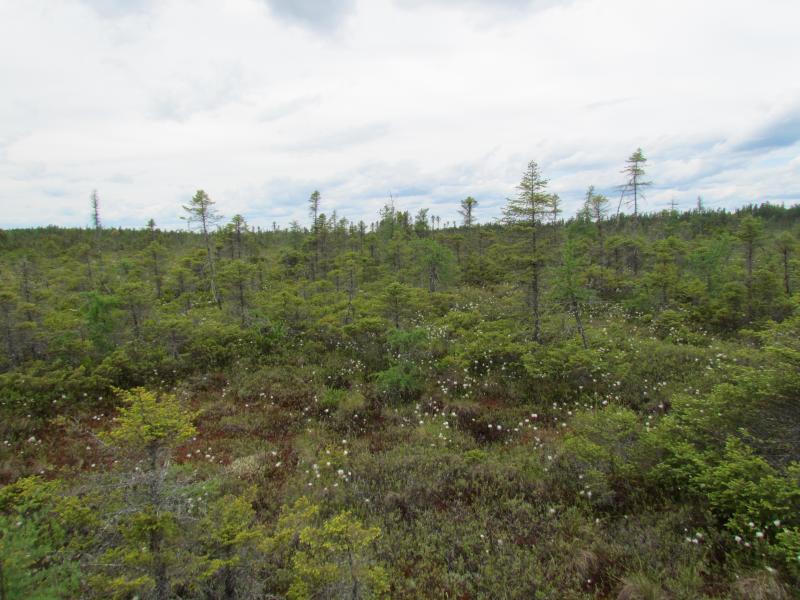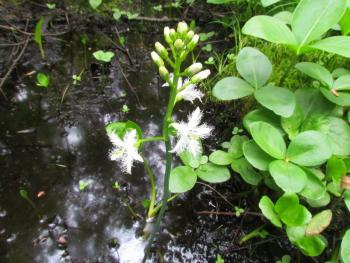For Father’s Day, Dad’s indulgence (well actually, Mom’s, too) was to try to find a Lincoln’s sparrow — a bird that we had missed during spring migration this year. In pursuit of our mindfulness Big Year (as we wrote about here), we realized we needed to visit a very special Maine habitat — a sphagnum bog — during the summer breeding season. That’s where you find Lincoln’s sparrows. We wrote about the fascinating story of how young Tom Lincoln from Washington County, Maine, had joined John James Audubon on his trip to Labrador in the early 1800s and had taken the first specimen of a species that Audubon had never encountered. In his honor, Audubon named the bird for him and so we have the Lincoln’s sparrow.
Lincoln’s sparrows reach the southern limit of their breeding range across northern New England and New York. That’s because they are adapted to northern boggy habitats for nesting—habitats that reach their southern extent as patches in New England and the Adirondacks of New York. Here in Maine, they nest only about as far south as Bangor. Technically the southern limit may be Orono since the place they occur there is a sphagnum bog that is literally nestled up against the line between Orono and Bangor, a mere mile or so away from the bustling complex of malls and big box stores most people know as the Bangor Mall.
So for Father’s Day, the family took a drive up to Bangor in search of a Lincoln’s sparrow in what is today known as the Orono Bog, a special place protected in part thanks to countless volunteers, the Orono Land Trust, and the Land for Maine’s Future program. When the father in question (Jeff) was a young high school birder growing up in Bangor, no one seemed to be aware that the bog itself was over the town line in Orono, as most birders called it the Bangor Bog. Back in those days very few people ventured into the bog because it required bushwalking across a roadside ditch and through heavy brush and wet pools while trying to balance on the quaking carpet of deep floating sphagnum.
Father told stories to son Evan and spouse (Allison) of those days while walking down a groomed woodland path and out onto a wide, floating recycled plastic boardwalk that now makes experiencing the bog easy and comfortable even for families pushing baby strollers, which there were many of on Father’s Day. The access was much, much easier than in Jeff’s boyhood days, but the mosquitoes and black flies were just as bad as they were those years ago.
The trail was beautiful and soothingly surrounded by an explosion of greenery--cinnamon ferns and royal ferns looking luxuriantly thick in the understory. Woodland flowers were everywhere: pink lady slippers, showy white bunchberries, mayflowers, three-leaved false Solomon’s seal, and a new one for us (don’t know why we had never encountered it before), the feathery white-flowered bogbean.
The birds didn’t disappoint us either. Magnolia, pine, black-throated green, black-and-white, and Nashville warblers; northern waterthrush, hermit thrushes, veery, red-breasted nuthatch, and even a drumming ruffed grouse.
Out in the open bog we marveled at pitcher plants, Labrador tea bushes with the rusty hairs on the undersides of the leaves, pink star-shaped flowers of bog laurels, and by searching carefully, found some tiny sundew plants. We reveled in the northern smells of peat and spruce wafting through the air on gentle breezes and could easily imagine we were up in Labrador or Quebec, far to the north. Palm warblers sang their weak trills from the top of stunted black spruces. A few times, the piercing “Old Sam Peabody” song of a white-throated sparrow burst from closer to the brushy edges of the bog. We listened and listened for the finchy song of the Lincoln’s sparrow (Audubon had actually first named it Lincoln’s finch—perhaps because of its song?). But it was not to be this Father’s Day. That’s not such a bad thing since it just means we must search again for this beautiful bird—perhaps at the Orono Bog again, perhaps somewhere else.
We ended the day by visiting a place that served one of Evan’s favorite beverages — bubble tea. And we succeeded, locating a restaurant only a few minutes away that let us celebrate our Father’s Day birding adventure with a nice lunch and some bubble tea, capping a wonderful day bogging and birding.
Jeffrey V. Wells, Ph.D., is a Fellow of the Cornell Lab of Ornithology. Dr. Wells is one of the nation's leading bird experts and conservation biologists, and is author of the “Birder’s Conservation Handbook.” His grandfather, the late John Chase, was a columnist for the Boothbay Register for many years. Allison Childs Wells, formerly of the Cornell Lab of Ornithology, is a senior director at the Natural Resources Council of Maine, a nonprofit membership organization working statewide to protect the nature of Maine. Both are widely published natural history writers and are the authors of the popular books, “Maine’s Favorite Birds” (Tilbury House) and “Birds of Aruba, Bonaire, and Curaçao: A Site and Field Guide,” (Cornell University Press).































